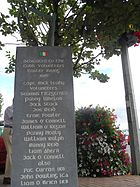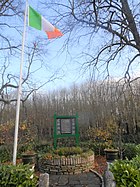
Easter Rising
The Easter Rising (Irish: Éirí Amach na Cásca),[2] also known as the Easter Rebellion, was an armed insurrection in Ireland during Easter Week in April 1916. The Rising was launched by Irish republicans against British rule in Ireland with the aim of establishing an independent Irish Republic while the United Kingdom was fighting the First World War. It was the most significant uprising in Ireland since the rebellion of 1798 and the first armed conflict of the Irish revolutionary period. Sixteen of the Rising's leaders were executed starting in May 1916. The nature of the executions, and subsequent political developments, ultimately contributed to an increase in popular support for Irish independence.
This article is about the armed insurrection in Ireland. For the musical, see Easter Rising (musical).
Organised by a seven-man Military Council of the Irish Republican Brotherhood, the Rising began on Easter Monday, 24 April 1916 and lasted for six days.[3] Members of the Irish Volunteers, led by schoolmaster and Irish language activist Patrick Pearse, joined by the smaller Irish Citizen Army of James Connolly and 200 women of Cumann na mBan seized strategically important buildings in Dublin and proclaimed the Irish Republic. The British Army brought in thousands of reinforcements as well as artillery and a gunboat. There was street fighting on the routes into the city centre, where the rebels slowed the British advance and inflicted many casualties. Elsewhere in Dublin, the fighting mainly consisted of sniping and long-range gun battles. The main rebel positions were gradually surrounded and bombarded with artillery. There were isolated actions in other parts of Ireland; Volunteer leader Eoin MacNeill had issued a countermand in a bid to halt the Rising, which greatly reduced the extent of the rebel actions.
With much greater numbers and heavier weapons, the British Army suppressed the Rising. Pearse agreed to an unconditional surrender on Saturday 29 April, although sporadic fighting continued briefly. After the surrender, the country remained under martial law. About 3,500 people were taken prisoner by the British and 1,800 of them were sent to internment camps or prisons in Britain. Most of the leaders of the Rising were executed following courts martial. The Rising brought physical force republicanism back to the forefront of Irish politics, which for nearly fifty years had been dominated by constitutional nationalism. Opposition to the British reaction to the Rising contributed to changes in public opinion and the move toward independence, as shown in the December 1918 election in Ireland which was won by the Sinn Féin party, which convened the First Dáil and declared independence.
Of the 485 people killed,[1] 260 were civilians, 143 were British military and police personnel, and 82 were Irish rebels, including 16 rebels executed for their roles in the Rising. More than 2,600 people were wounded. Many of the civilians were killed or wounded by British artillery fire or were mistaken for rebels. Others were caught in the crossfire during firefights between the British and the rebels. The shelling and resulting fires left parts of central Dublin in ruins.
The Easter Rising resulted in at least 485 deaths, according to the Glasnevin Trust.[1][157][158]
Of those killed:
More than 2,600 were wounded; including at least 2,200 civilians and rebels, at least 370 British soldiers and 29 policemen.[159] All 16 police fatalities and 22 of the British soldiers killed were Irishmen.[160] About 40 of those killed were children (under 17 years old),[161] four of whom were members of the rebel forces.[162]
The number of casualties each day steadily rose, with 55 killed on Monday and 78 killed on Saturday.[1] The British Army suffered their biggest losses in the Battle of Mount Street Bridge on Wednesday when at least 30 soldiers were killed. The rebels also suffered their biggest losses on that day. The RIC suffered most of their casualties in the Battle of Ashbourne on Friday.[1]
The majority of the casualties, both killed and wounded, were civilians. Most of the civilian casualties and most of the casualties overall were caused by the British Army.[163] This was due to the British using artillery, incendiary shells and heavy machine guns in built-up areas, as well as their "inability to discern rebels from civilians".[163] One Royal Irish Regiment officer recalled, "they regarded, not unreasonably, every one they saw as an enemy, and fired at anything that moved".[163] Many other civilians were killed when caught in the crossfire. Both sides, British and rebel, also shot civilians deliberately on occasion; for not obeying orders (such as to stop at checkpoints), for assaulting or attempting to hinder them, and for looting.[163] There were also instances of British troops killing unarmed civilians out of revenge or frustration: notably in the North King Street Massacre, where fifteen were killed, and at Portobello Barracks, where six were shot.[164] Furthermore, there were incidents of friendly fire. On 29 April, the Royal Dublin Fusiliers under Company Quartermaster Sergeant Robert Flood shot dead two British officers and two Irish civilian employees of the Guinness Brewery after he decided they were rebels. Flood was court-martialled for murder but acquitted.[165]
According to the historian Fearghal McGarry, the rebels attempted to avoid needless bloodshed. Desmond Ryan stated that Volunteers were told "no firing was to take place except under orders or to repel attack".[166] Aside from the engagement at Ashbourne, policemen and unarmed soldiers were not systematically targeted, and a large group of policemen was allowed to stand at Nelson's Pillar throughout Monday.[166] McGarry writes that the Irish Citizen Army "were more ruthless than Volunteers when it came to shooting policemen" and attributes this to the "acrimonious legacy" of the Dublin Lock-out.[166]
The vast majority of the Irish casualties were buried in Glasnevin Cemetery in the aftermath of the fighting.[1][157] British families came to Dublin Castle in May 1916 to reclaim the bodies of British soldiers, and funerals were arranged. Soldiers whose bodies were not claimed were given military funerals in Grangegorman Military Cemetery.
1916 – containing both the Rising and the Battle of the Somme, events paramount to the memory of Irish Republicans and Ulster Unionists, respectively – had a profound effect on Ireland and is remembered accordingly.[228][j] The Rising was among the events that ended colonial rule in Ireland, succeeded by the Irish War of Independence.[233] The legacy of the Rising possess many dimensions although the declaration of the Republic and the ensuing executions remain focal points.[234]
Annual parades in celebration of the Rising occurred for many years, however, ceased after The Troubles in Northern Ireland began, being seen as supportive of republican paramilitary violence – the Rising is a common feature of republican murals in Northern Ireland.[228][235][k] These commemorations celebrated the Rising as the origin of the Irish state, a stance reiterated through extensive analysis.[238][239] Unionists contend that the Rising was an illegal attack on the British State that should not be celebrated.[237] Revivalism of the parades has inspired significant public debate, although the centenary of the Rising, which featured the likes of ceremonies and memorials, was largely successful and praised for its sensitivity.[228][240][l]
The leaders of the Rising were "instantly apotheosized" and remembrance was situated within a larger republican tradition of claimed martyrdom – the Catholic Church would contend this narrative as the foundational myth of the Irish Free State, assuming a place within the remembrance as an association between republicanism and Catholicism grew.[228][242][191][m] The "Pearsean combination of Catholicism, Gaelicism, and spiritual nationalism" would become dominant within republicanism, the ideas gaining a quasi-religiosity.[246][247] Within the Free State, the Rising was sanctified by officials, positioned as a "highly disciplined military operation".[248] Historians largely agree that the Rising succeeded by offering a symbolic display of sacrifice, while the military action was a considerable failure.[249][n] As Monk Gibbon remarked, the "shots from khaki-uniformed firing parties did more to create the Republic of Ireland than any shot fired by a Volunteer in the course of Easter week".[252]
Literature surrounding the Rising was significant: MacDonagh, Plunkett, and Pearse were themselves poets, whose ideals were granted a spiritual dimension in their work; Arnold Bax, Francis Ledwidge, George William Russell and W. B. Yeats responded through verse that ranged from endorsement to elegies.[253][o] Although James Joyce was ambivalent to the insurgence, metaphors of and imagery consistent with the Rising appear in his later work.[251] Hugh Leonard, Denis Johnston, Tom Murphy, Roddy Doyle and Sorley MacLean are among writers would later invoke the Rising.[255][256] Now extensively dramatised, its theatricality was identified in the moment and has been stressed in its remembrance.[257] Literary and political evocation position the Rising as a "watershed moment" central to Irish history.[258]
Black, Basque, Breton, Catalan and Indian nationalists have drawn upon the Rising and its consequences.[259][260][261][262] For the latter, Jawaharlal Nehru noted, the symbolic display was the appeal, that of the transcendent, "invincible spirit of a nation"; such was broadly appealing in America, where diasporic, occasionally socialist, nationalism occurred.[259][263][264][p] Vladimir Lenin was effusive, ascribing its anti-imperialism a singular significance within geopolitics – his only misgiving was its estrangement from the broader wave of revolution occurring.[267][q]
During the Troubles, significant revisionism of the Rising occurred. Revisionists contended that it was not a "heroic drama" as thought but rather informed the violence transpiring, by having legitimised a "cult of 'blood sacrifice'".[270][271] With the advent of a Provisional IRA ceasefire and the beginning of what became known as the Peace Process during the 1990s, the government's view of the Rising grew more positive and in 1996 an 80th anniversary commemoration at the Garden of Remembrance in Dublin was attended by the Taoiseach and leader of Fine Gael, John Bruton.[272]




